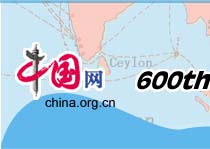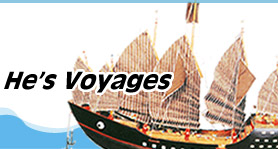


 |
 |
 |
|
Copyright © China Internet Information Center. All Rights Reserved E-mail: webmaster@china.org.cn Tel: 86-10-68326688 |
| Taicang is a coastal city in east China's Jiangsu Province. Located along the Yangtze River, Taicang was the place where Zheng He began his great voyages. Taicang became an important port early during the Three Kingdoms period (220-280), and its economy flourished in the Tang Dynasty (618-907). The city reached its peak in the Yuan Dynasty (1271-1368), being the "No. 1 Port in the World". The fine harbor, abundant storage of various materials as well as advanced shipbuilding also guaranteed Zheng He's voyages. |
| Changle, located in South China's Fujian Province, was the base and the place where Zheng He's fleets sailed to the ocean. Though some of his seven voyages began from Taicang or Nanjing, they always arrived Changle first for the preparations. |
| Champa is in the mid-south part of Vietnam. In the third year of the Yongle reign (1405), the first stop the Zheng He's fleet made was at Champa. According to Ming Dynasty historical records, Zheng He visited Champa five more times, establishing a solid friendship with the local populace. He also built a shipping and trading center here. The Chinese cultural influence introduced by Zheng He can still be seen in the architecture of Champa's palaces. Because of its vicinity to the sea, it provided great advantage to communicate with the neighboring countries. Today, the place is still characterized with its multi-culture flavor. |
| Siam (present day Thailand) is the geographical heart of South-East Asia. Zheng He's fleets reached the place for three times altogether, hence there are a lot of relics that can still be found today, including a temple after Zheng's name, fresco of Zheng's fleets as well as a harbor after his name. On each occasion he visited Siam, Zheng He also traded Chinese silks, porcelain, and other specialties. Chinese porcelain enriched and beautified the lives of the people of Siam, while Chinese architectural design and stone carving had a great influence on Thai esthetics. |
| Malacca is an important port and trading center. During the 15th century, it was the biggest shipping center in Southeast Asia. Today, there are still a lot of relics memorizing Zheng He's visits hundreds of years ago and Malacca is an illustrious historic city -- a melting pot of historical treasures and cultures. |
| Borneo is present day Brunei in Borneo Island of Kalimanta Island. In the sixth year of the Yongle reign (1408), the Emperor of Borneo, with his queen and prince, came to China with Zheng He. The group consisted of more than 150 people and was warmly received. |
| Semudra, currently known as Sumatra, was then a small country. Because of its advantageous geological location, all ships traversing the Straits of Malacca had to pass by Semudra, making it a flourishing maritime trade center. |
| Java, in present day Indonesia, is a major island of the country. With a great number of Chinese guildhalls and schools, Java has the biggest Chinese population in Indonesia. At the beginning of the 15th century, Zheng He's fleets sailed along China's coast down to the south, and Java was the southernmost place Zheng He had ever reached. |
| Ceylon, currently called Sri Lanka, is an island country in the Indian Ocean off southeast India. Zheng He once established a stele recording the friendship between the two countries, with its epigraphs written in three languages: Chinese, Tamil and Persian. As a piece of very precious cultural relics, the stele is being collected in the country's national museum. The island has many nicknames: Serendib, Teardrop of India, Resplendent Isle, Island of Dharma and Pearl of the Orient etc. This colorful collection reveals its richness and beauty. |
| Ormus is in the present day Iran. Zheng He visited Ormus during his fourth voyage in 1415. The King of Ormus presented some pearls, gems and other precious animals including lions and giraffes. Ormus was a kingdom in the 16th and 17th centuries around the Persian Gulf, in particular the Strait of Hormus. The capital was the fortified port-city of Ormus which was one of the most important ports in the Middle East at the time, controlling sea-way trading routes to India. The city was probably located on the island of Hormoz. |
| Mecca is the most sacred site in the Muslim world. It is where the prophet Mohammed first started teaching and is known as the cradle of Islam. As a Muslim, Zheng He had a strong desire and religious duty to make the pilgrimage to the holy city of Mecca. By successfully reaching Mecca, Zheng He was instrumental in forging ties between the Ming Dynasty and the Islamic countries of the Middle East. |